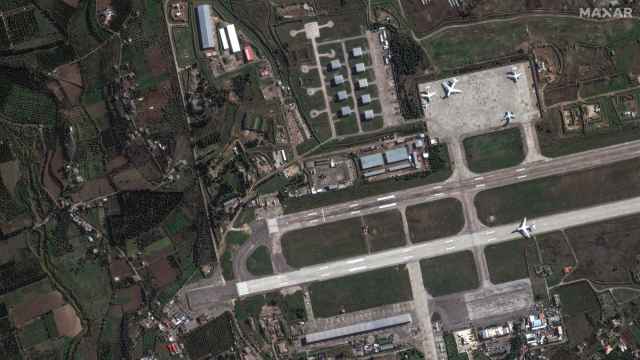Rafts carrying people have been spotted off the far eastern coast where a floating oil rig sank in remote, freezing waters, the owner said Monday, but the government would not confirm the report and it was not clear whether there were survivors.
Time appeared to be running out for the scores of oil workers still missing the day after their floating platform was downed in a severe storm. Workers have already pulled out 10 bodies from the Sea of Okhotsk, and there are four more bodies that haven't been retrieved yet, the Emergency Situations Ministry said.
Of the 67 men aboard, 14 were plucked alive from the icy waters immediately after the accident and taken to a hospital.
The chances of survival are negligible, as the water temperature in the area is 1 degree Celsius.
An official at the rig's owner, Arktikmorneftegazrazvedka, who asked not to be identified because the offshore oil exploration firm is not authorized to comment on the rescue operation, said rescue vessels had spotted four rafts with people aboard, but it was not clear whether they were alive or not.
The Emergency Situations Ministry and military officials would not confirm the sighting.
The ministry said there were four vessels, one helicopter and one airplane in the area searching for the missing men. Helicopter shots from the area on NTV television showed nothing floating on the partly ice-bound sea.
Russia produces most of its oil onshore, and it hasn't seen any significant oil platform accidents in the past years.
The floating oil rig capsized Sunday morning as it was being towed about 200 kilometers off the coast of Sakhalin Island amid a fierce storm. It started sinking after a strong wave broke some of its equipment and the portholes in the crew's dining room.
One of the survivors, Sergei Grauman, said on Channel One state television that the platform's portholes were smashed in a second and the crew had struggled to fix them.
"Everyone rushed to the deck," he said. "It all felt like a movie."
The Kolskaya platform — 70 meters long and 80 meters wide — was built in Finland in 1985. It has recently done some work for Gazprom and was on its way to a port in the Far East when it capsized.
There has been no report of environmental damage, but there is likely to be little because the rig only carried a small amount of fuel.
National newspapers on Monday speculated about whether there could have been fewer deaths if the rig's owner had taken more people off the rig before it was moved.
Federal law allows only a "minimal number of crew members" to be aboard the platform while it is being towed and bars any noncrew members or passengers. Reports said at least 14 people aboard were not crew members.
A Message from The Moscow Times:
Dear readers,
We are facing unprecedented challenges. Russia's Prosecutor General's Office has designated The Moscow Times as an "undesirable" organization, criminalizing our work and putting our staff at risk of prosecution. This follows our earlier unjust labeling as a "foreign agent."
These actions are direct attempts to silence independent journalism in Russia. The authorities claim our work "discredits the decisions of the Russian leadership." We see things differently: we strive to provide accurate, unbiased reporting on Russia.
We, the journalists of The Moscow Times, refuse to be silenced. But to continue our work, we need your help.
Your support, no matter how small, makes a world of difference. If you can, please support us monthly starting from just $2. It's quick to set up, and every contribution makes a significant impact.
By supporting The Moscow Times, you're defending open, independent journalism in the face of repression. Thank you for standing with us.
Remind me later.





